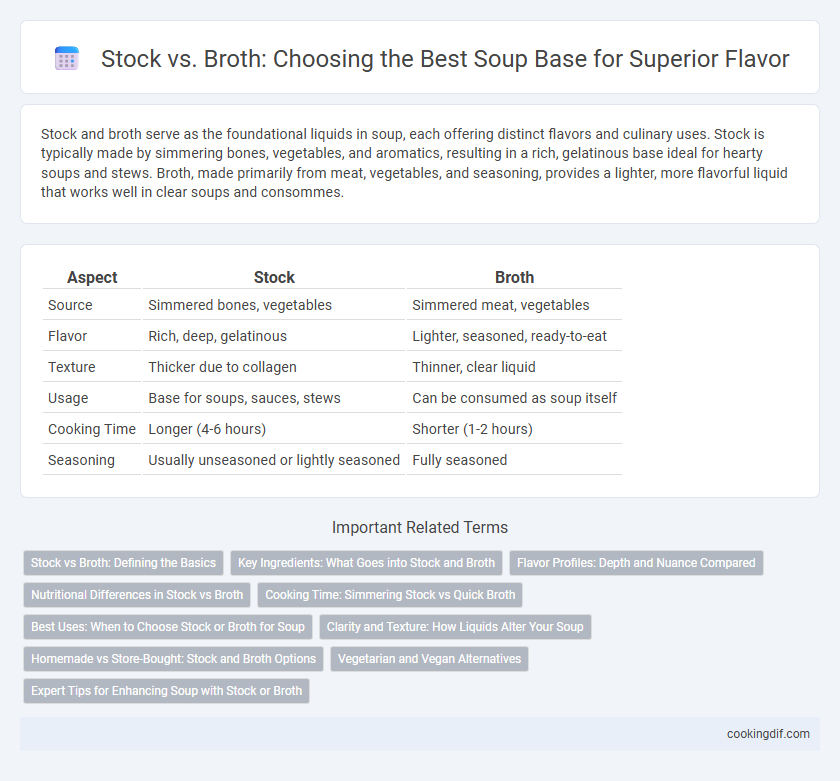Stock and broth serve as the foundational liquids in soup, each offering distinct flavors and culinary uses. Stock is typically made by simmering bones, vegetables, and aromatics, resulting in a rich, gelatinous base ideal for hearty soups and stews. Broth, made primarily from meat, vegetables, and seasoning, provides a lighter, more flavorful liquid that works well in clear soups and consommes.
Table of Comparison
| Aspect | Stock | Broth |
|---|---|---|
| Source | Simmered bones, vegetables | Simmered meat, vegetables |
| Flavor | Rich, deep, gelatinous | Lighter, seasoned, ready-to-eat |
| Texture | Thicker due to collagen | Thinner, clear liquid |
| Usage | Base for soups, sauces, stews | Can be consumed as soup itself |
| Cooking Time | Longer (4-6 hours) | Shorter (1-2 hours) |
| Seasoning | Usually unseasoned or lightly seasoned | Fully seasoned |
Stock vs Broth: Defining the Basics
Stock and broth serve as fundamental liquids in soup preparation, with stock made primarily from simmering bones, vegetables, and aromatics to extract gelatin and rich flavors, resulting in a thicker consistency. Broth is typically made by boiling meat, vegetables, and seasonings, yielding a lighter, clearer liquid that can be consumed on its own. Understanding the differences in cooking time, flavor depth, and texture helps chefs choose the ideal base for enhancing soup recipes.
Key Ingredients: What Goes into Stock and Broth
Stock is typically made by simmering bones, vegetables, and aromatics such as onions, celery, and carrots over several hours to extract rich gelatin and deep flavors, resulting in a thicker, more robust base. Broth primarily consists of meat, vegetables, and seasonings cooked for a shorter time, producing a lighter and clearer liquid with a more straightforward taste. Key ingredients for stock emphasize collagen-rich bones and mirepoix, while broth relies on the tenderness and flavor of meat and herbs.
Flavor Profiles: Depth and Nuance Compared
Stock offers a rich, savory foundation derived from simmering bones, vegetables, and herbs, resulting in a deep, gelatinous texture that enhances soup's mouthfeel. Broth, made primarily from meat and aromatic vegetables, provides a lighter, clearer liquid with a more straightforward, clean flavor profile ideal for delicate soups. The nuanced depth of stock lends complexity to hearty dishes, while broth's subtle taste allows other ingredients to shine without overpowering the soup.
Nutritional Differences in Stock vs Broth
Stock contains higher collagen and gelatin levels due to prolonged simmering of bones and connective tissues, resulting in richer protein content and beneficial amino acids like glycine and proline. Broth, made primarily from meat and vegetables simmered for shorter periods, generally offers lighter flavor and fewer nutrients but retains minerals and some vitamins. Nutritionally, stock provides more joint-supporting compounds, while broth delivers hydration with moderate electrolyte content, making each suitable for different dietary needs.
Cooking Time: Simmering Stock vs Quick Broth
Stock requires several hours of simmering, typically 4 to 6 hours, allowing collagen and bones to release gelatin and rich flavors, resulting in a thicker, more robust base. Broth cooks faster, generally simmering for 45 minutes to 2 hours, extracting lighter flavors primarily from meat and vegetables but without the depth of gelatinous texture found in stock. The extended cooking time of stock enhances mouthfeel and complexity, making it ideal for hearty soups, while broth offers a quick and flavorful option for lighter soups or everyday use.
Best Uses: When to Choose Stock or Broth for Soup
Stock, made by simmering bones with vegetables and herbs, offers a rich, gelatinous base ideal for hearty soups like stews and chowders. Broth, typically prepared from meat, vegetables, and seasoning, provides a lighter, more flavorful liquid perfect for clear soups and consommes. Choosing stock enhances body and depth, while broth delivers a clean, savory taste suited for delicate soups and quick meals.
Clarity and Texture: How Liquids Alter Your Soup
Stock provides a rich, gelatinous texture due to its collagen content from simmered bones, enhancing soup body and mouthfeel, whereas broth offers a clearer, lighter liquid extracted mainly from meat and vegetables. The choice between stock and broth directly influences the clarity and consistency of soup, with stock creating a thicker, more opaque base and broth yielding a transparent, delicate soup liquid. Understanding these differences helps in selecting the ideal liquid to achieve the desired soup texture and appearance.
Homemade vs Store-Bought: Stock and Broth Options
Homemade stock offers richer flavor and gelatinous texture due to slow-cooked bones and vegetables, enhancing soup depth compared to most store-bought broths, which tend to be lighter and saltier with added preservatives. Store-bought broths provide convenience and consistent flavor, ideal for quick meals, but may lack the nutritional benefits and complexity of homemade stock. Choosing between stock and broth hinges on desired soup richness and preparation time, with homemade stock favored for gourmet soups and store-bought broth suiting everyday cooking.
Vegetarian and Vegan Alternatives
Vegetarian and vegan soups often use vegetable stock or broth as the liquid base, offering rich flavors derived from simmered vegetables, herbs, and spices without animal products. Vegetable stock typically serves as a nutrient-rich foundation made by boiling vegetables such as carrots, celery, onions, and mushrooms, while vegetable broth is often lighter and seasoned for direct consumption. Popular plant-based alternatives include miso broth, kombu dashi, and mushroom broth, which enhance umami flavor in vegan and vegetarian soups without compromising dietary preferences.
Expert Tips for Enhancing Soup with Stock or Broth
Stock, made by simmering bones and aromatics, provides a rich, gelatinous base that enhances the depth and mouthfeel of soups, while broth, typically seasoned and lighter, offers a quicker, flavorful option. Experts recommend using homemade stock for hearty, slow-cooked soups like beef stew or bone broth soups to maximize nutrients and complexity. For lighter soups or quick meals, high-quality store-bought broth can be elevated by simmering with fresh herbs, garlic, or vegetables to boost flavor naturally.
Stock vs Broth for soup liquid Infographic

 cookingdif.com
cookingdif.com